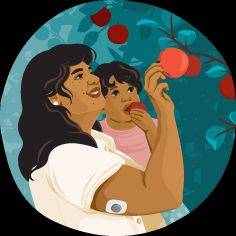A low carb diet typically has you limit bread, sweets, and starchy vegetables. Certain types of fruit may also be high in carbs.
Carbs are an important source of energy and one of the three main macronutrients in our diets, along with fat and protein.
Carbohydrates fuel the brain and cells throughout the body and regulate digestive health, appetite, cholesterol levels, and more.
Still, many people choose to limit their carb intake. Researchers have
On a low carb diet, you may need to limit certain foods high in carbs and sugar. You make up for the reduction by increasing proteins and healthy fats.
Your total daily carb target determines whether you need to limit some of these foods or avoid them altogether. Low carb diets typically contain
Keep reading to learn which foods to limit and avoid on a low carb diet.
Counting net carbs
When counting carbs on a low carb eating plan, nutritionists typically recommend counting net carbs rather than total carbs. To find the net carbs, you can subtract the fiber from the total carbohydrates listed under a food’s nutritional information since fiber is not digested.
Here are 14 foods to limit on a low carb diet.
Bread is a staple food in many cultures but is typically high in carbs.
Although exact counts vary by ingredients and portion size, bread made from whole grains typically has a lower amount of carbs when compared to those made from refined flour. It also contains more beneficial nutrients, including fiber.
The carbs in whole grain products can vary by product and portion size.
To reduce the number of carbs you’re eating, you can manage the amount of bread and grains you eat. You can try making some whole grain swaps, like:
- whole wheat bread instead of white bread:
- 1 larger slice (32 grams) of whole wheat bread:
13 gramsTrusted Source of carbs (11 grams net carbs) - 1 smaller slice (27 grams) of white bread:
13 gramsTrusted Source of carbs (12.2 grams net carbs)
- 1 larger slice (32 grams) of whole wheat bread:
- brown or purple rice instead of white rice
- brown rice, uncooked (100 grams or about 1/2 cup uncooked, 1-1/2 cups cooked):
77 gramsTrusted Source of carbs (74 grams net carbs) - white rice, uncooked (100 grams):
80 gramsTrusted Source of carbs (77 grams net carbs)
- brown rice, uncooked (100 grams or about 1/2 cup uncooked, 1-1/2 cups cooked):
- whole wheat tortillas, flatbread, or pita instead of varieties made from refined flour
- whole wheat tortillas (1 tortilla, 41 grams):
19 gramsTrusted Source of carbs (15 grams net carbs) - flour tortillas (1 tortilla, 49 grams):
24 gramsTrusted Source of carbs (23 grams net carbs)
- whole wheat tortillas (1 tortilla, 41 grams):
You can also make low carb bread.
You can also include other whole grains in your eating plan, such as:
Eating lots of whole fruits and veggies has consistently been linked to a lower risk of
While fruits can be high in carbs, many are high in fiber, reducing the number of net carbs.
Some low carb swaps may include:
- whole peaches, plums, and nectarines instead of varieties canned in syrup
- 1 whole peach (147 grams):
15 gramsTrusted Source of carbs (13 grams net carbs) - 1 cup canned peaches in heavy syrup (262 grams):
52 gramsTrusted Source of carbs (49 grams net carbs)
- 1 whole peach (147 grams):
- a half-cup of fresh berries or cut apples instead of dried and sweetened cranberries
- 1 cup raspberries (123 grams):
15 gramsTrusted Source of carbs (7 grams net carbs) - 1 cup sliced golden delicious apple (109 grams):
15 gramsTrusted Source of carbs (12 grams net carbs) - 1/4 cup sweetened cranberries (40 grams):
33 gramsTrusted Source of carbs (31 grams net carbs)
- 1 cup raspberries (123 grams):
Berries are lower in sugar and higher in fiber than other fruits. This makes berries suitable for low carb diets. Other low carb fruits can include:
You can also try adding fruits high in healthy fats to your diet. This may include:
Most diets allow an unlimited intake of vegetables.
Plus, many veggies are very high in fiber,
Starchy vegetables contain more digestible carbs than fiber. On a low carb diet, you may want to enjoy them in moderation. Here are the carb counts for 100 grams of some cooked starchy vegetables:
- Sweet corn:
19 gramsTrusted Source (16 grams net) - Potatoes:
12 gramsTrusted Source ( 10 grams net) - Sweet potatoes:
21 gramsTrusted Source (18 grams net) - Peas:
25 gramsTrusted Source (16 grams net) - Butternut squash:
11 gramsTrusted Source (8 grams net)
Notably, you can enjoy many low carb vegetables on a low carb diet. Here are the carb counts for 100 grams of some low carb vegetables:
- Bell peppers:
5 gramsTrusted Source (4 grams net) - Asparagus:
4 gramsTrusted Source (2 grams net) - Mushrooms:
4 gramsTrusted Source (2 grams net) - Baby spinach:
2 gramsTrusted Source (1 gram net)
Though pasta is versatile and inexpensive, it’s also high in carbs. Choosing a whole wheat variety is typically lower in carbs.
Just 1 cup (151 grams) of cooked spaghetti packs
You can also look for pasta that isn’t made of wheat. Many versions contain high amounts of fiber and result in a reduced amount of net carbs. These numbers can vary by product. Low carb pasta alternatives can include:
- spiralized vegetables, such as zucchini
- spaghetti squash
- chickpea pasta
- veggie pasta
- lentil pasta
- shirataki noodles
You can also substitute rice for pasta in some instances. Opt for brown or purple rice instead of white rice, as they have more fiber and are less processed. Here are the carb counts for 100 grams of rice (or around 1/2 cup uncooked, which makes between 1-1 1/2 cups cooked):
- brown rice:
77 gramsTrusted Source of carbs (74 grams net carbs) - white rice:
80 gramsTrusted Source of carbs (77 grams net carbs)
Sugary breakfast cereals usually contain a lot of carbs and added sugar.
But if you choose options high in fiber and control your portion size, some cereals can be included in a low carb diet.
- Cooked instant oats (1 cup cooked):
28 gramsTrusted Source of carbs (24 grams net carbs) - Steel-cut oats (1/4 cup dry):
28 gramsTrusted Source of carbs (23 grams net carbs) - Granola (1/2 cup):
35 gramsTrusted Source of carbs (30 grams net carbs)
You can also make your granola or muesli and more directly control the amount of carbs and added sugar. Some potential low carb ingredients include:
- oats
- quinoa flakes
- nuts
- chia seeds
- hemp seed
You can enjoy alcohol in moderation on a low carb diet.
But beer is fairly high in carbs. On average, a 12-ounce (360-mL) can of beer packs
If you’re drinking hard liquors, mixers can be a source of sugar and carbs. This can make the carbs add up quickly.
Many people tend to eat fruit-flavored, sweetened yogurt varieties, which often contain as many carbs as desserts.
One cup (245 grams) of nonfat sweetened fruit yogurt contains about
Instead, it’s best to opt for unsweetened, plain yogurt when possible and add your favorite low carb toppings. For instance, 1/2 cup (123 grams) of
Although it contains some valuable vitamins and minerals, juice is high in carbs and low in fiber, which can make it challenging to fit into a low carb diet. Many varieties also contain added sugar.
- Apple juice (12 ounces, 355 mL):
42 gramsTrusted Source of carbs - Grape juice (12 ounces, 355 mL):
55 gramsTrusted Source of carbs - Vegetable juice (12 ounces, 355 mL):
14 gramsTrusted Source of carbs (12 net carbs)
You may want to watch your juice intake on a low carb diet. Instead of juice and other sugary drinks, you may be able to make low carb smoothies or opt for water or tea.
You can eat a wide variety of salads on a low carb diet.
But commercial dressings, especially low fat and fat-free varieties, can add more carbs than expected.
For example, 2 tablespoons (30 mL) of fat-free French dressing contain
To minimize carbs, dress your salad with a creamy, full-fat dressing. You can also make homemade vinaigrette using a splash of vinegar and extra virgin olive oil, which is
Beans and legumes provide many health benefits, including
While they’re high in carbs, they also contain a fair amount of fiber.
Here are the carb counts for 1 cup (160–200 grams) of cooked beans and legumes:
- Lentils:
39 gramsTrusted Source (23 grams net) - Peas:
25 gramsTrusted Source (16 grams net) - Black beans:
41 gramsTrusted Source (26 grams net) - Pinto beans:
45 gramsTrusted Source (30 grams net) - Chickpeas:
45 gramsTrusted Source (32 grams net) - Kidney beans:
37 gramsTrusted Source (26 grams net)
You’re probably well aware that foods high in refined white sugar, such as cookies, candy, and cake, should be limited on a low carb diet.
Natural forms of sugar can have as many carbs, if not more. They also typically have very little to no fiber.
Here are the carb counts per 1 tablespoon (13–21 grams) of several types of sugar:
- White sugar:
13 gramsTrusted Source - Maple syrup:
13 gramsTrusted Source - Agave nectar:
16 gramsTrusted Source - Honey:
17 gramsTrusted Source
Many sweeteners provide little to no nutritional value. When limiting your carb intake, it’s important to choose nutritious, high fiber carb sources.
To sweeten foods or beverages without adding carbs, choose a low carb sweetener, such as stevia or monk fruit.
Just 1 ounce (28 grams) of tortilla chips — or 10–15 average-sized chips — contains
Most people eat processed snack foods in large quantities, so you should limit them if you’re on a low carb diet.
You can try making veggie chips at home or shopping for less processed alternatives made from ingredients like:
You can also swap ultra-processed snack foods for hard-boiled eggs, cottage cheese, or nuts.
Milk is an excellent source of several nutrients, including calcium, potassium, and several B vitamins.
However, it’s also fairly high in carbs. If you’re only using 1–2 tablespoons (15–30 mL) in coffee each day, you may be able to include small amounts of milk in your low carb diet. Or, you could opt for creamer.
- Whole, low fat, and skim milk (8 ounces, 240 mL):
11Trusted Source to12.7Trusted Source grams of carbs - Cream (1 ounce, 30 mL):
1 gramTrusted Source of carbs - Half-and-half (1 ounce, 30 mL):
1 gramTrusted Source of carbs - Unsweetened almond milk (8 ounces, 240 mL):
3 gramsTrusted Source of carbs - Sweetened vanilla almond milk (8 ounces, 240 mL):
16 gramsTrusted Source of carbs (15 grams net carbs) - Unsweetened coconut milk (8 ounces, 240 mL):
6 gramsTrusted Source of carbs
Sweetened plant-based milk can contain more carbs than dairy milk.
If you enjoy drinking milk by the glass or using it to make lattes or smoothies, consider unsweetened almond or coconut milk.
Gluten is a group of proteins found in wheat, barley, and rye.
Some people with celiac disease or other gluten-related disorders must avoid gluten to manage digestive symptoms and prevent intestinal damage.
Gluten-free bread, muffins, and other baked goods aren’t typically low in carbs. They often contain more carbs than their gluten-containing counterparts.
The flour used to make these foods is typically made from starches and grains that tend to raise blood sugar rapidly.
If you’re limiting your carb intake, stick to whole foods or use almond or coconut flour to make your own low carb baked goods rather than eating processed gluten-free foods.
Although a low carb diet isn’t right for everyone, people may reduce their carb intake for many reasons.
For example, research shows that low carb diets may support weight loss as effectively as other popular eating patterns, such as low fat diets. All the same, low carb diets
Low carb or carb-controlled diets are also often recommended to treat diabetes. One review of research reported that a low carb diet helped improve long-term blood sugar management in people with type 2 diabetes.
Research suggests very low carb diets like the ketogenic diet may also increase weight loss and improve insulin sensitivity, which may help enhance blood sugar management.
One study suggests that low carb diets may help reduce the effects of metabolic syndrome, a group of risk factors that may increase your risk of heart disease, stroke, and type 2 diabetes, in people with obesity.
Low carb diets can be healthy and have health benefits, especially for weight management and blood sugar management. A well-planned low carb diet can include a variety of nutrient-dense ingredients, including:
- high fiber fruits
- vegetables
- nuts
- seeds
Some types of low carb diets, like keto and Atkins, may be overly restrictive and unsustainable in the long run.
While the keto diet may aid short-term weight loss, it also limits many nutritious food groups and may
- constipation
- kidney stones
- fatty liver disease
- vitamin or mineral deficiencies
Very low carb diets
- children
- pregnant people
- people with certain chronic health conditions
Eating more plant-based fats and proteins while lowering your refined carbs and sugar intake can reduce your diabetes risk. However, low carb diets emphasizing animal protein and minimizing whole grains
That’s why it’s best to talk with a doctor or dietitian before lowering your carb intake drastically.
SummaryLow carb diets may have health benefits. But very low carb diets can be overly restrictive and contribute to adverse effects if followed long-term.
You may be able to eat a small amount of beans on a low carb diet, depending on your daily carb limit. While beans are high in carbohydrates, they also contain fiber and protein.
You can eat a small amount of beans on a low carb diet. The exact amount may depend on your set carb limit. Beans lower in carbs can include peas, green beans, lima beans, and soybeans.
Beans contain both carbohydrates and protein. While they are high in carbs, they also offer beneficial nutrients like fiber, vitamins, and protein.
When following a low carb diet, it’s important to choose foods that are highly nutritious but low in carbs.
Eating more plant-based fats and proteins while lowering refined carbs and sugar intake can benefit your health.






